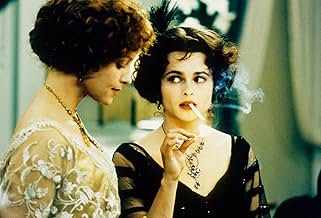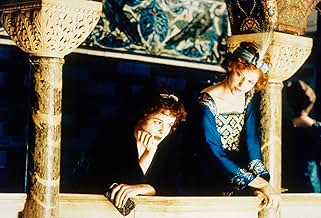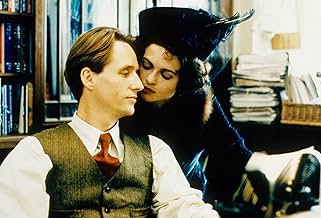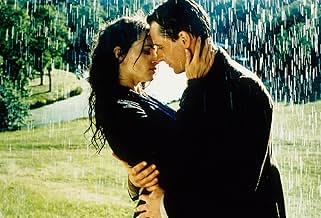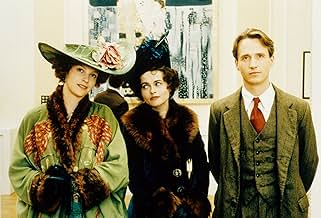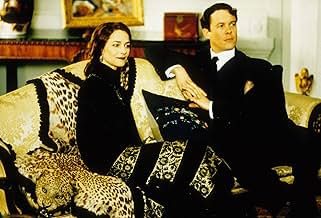Ajouter une intrigue dans votre langueAn impoverished woman who has been forced to choose between a privileged life with her wealthy aunt and her journalist lover, befriends an American heiress. When she discovers the heiress is... Tout lireAn impoverished woman who has been forced to choose between a privileged life with her wealthy aunt and her journalist lover, befriends an American heiress. When she discovers the heiress is attracted to her own lover and is dying, she sees a chance to have both the privileged li... Tout lireAn impoverished woman who has been forced to choose between a privileged life with her wealthy aunt and her journalist lover, befriends an American heiress. When she discovers the heiress is attracted to her own lover and is dying, she sees a chance to have both the privileged life she cannot give up and the lover she cannot live without.
- Réalisation
- Scénario
- Casting principal
- Nommé pour 4 Oscars
- 16 victoires et 32 nominations au total
- Royal Bodyguard
- (non crédité)
- Man in Boat Queue
- (non crédité)
- Carriage Driver
- (non crédité)
- Man in Bookshop
- (non crédité)
Avis à la une
Yes, this is a quite, indirect, thoughtful movie. But it is never slow. And the acting is incredible, almost as incredible as all the dresses and interior sets, which will blow anyone's mind. The story, by Henry James (the master of indirect but probing feelings), is about love of all kinds. And about being a good person, really. Three of the four main leads struggle with doing the right thing (and they do the right thing). The fourth struggles, falters, then comes forward again, then falters, finally, by making a demand that can never be met.
It's unfair to compare this kind of period movie (set around 1910 even though James's book was published in 1902) to "A Room with a View" (set in the same decade) but the reason this happens is that the 1985 Merchant-Ivory masterpiece seemed to open up a new way of making period films, filled with beauty and lingering thoughts and, well, feeling. Not the feeling two people have for each other, but a feeling of a time and place. It so happens the star of this 1997 film, Helena Bonham Carter, also starred (magnificently) in the first one.
The other star is a man, Linus Roache, who almost overplays his understated character by making him dry and deadpan and polite. But it works, over time, to help make the final few seconds of the film (which are so important) succeed. The third lead, really, in this lopsided triangle, is Alison Elliott, who puts in an equally subtle performance. So much of the movie is about little changes in facial expression, the acting had to rise to the needs of the plot. Bonham Carter, above all, does this with chilling perfection.
But those dresses! This is what is called Edwardian England, the first decade of the 20th Century, a time when modernity swept Europe with a passion (Picasso and Klimt) and when cars and other new technologies were surging. The styles of the dresses are part Art Nouveau, with its Asian influences, and part European excess, a showing off of style and wealth and material sensibility. Thank god! It's just breathtaking. The interiors are likewise brimming with tiles and flowers and paintings and light of all kinds.
All of this is handled with a cinematic control that reminds me of the color coordination of mid-century Technicolor films, where the palette of a scene is often limited to a pair of colors. You'll see many scenes where a mix of blue and rusty orange are the only two colors in various guises (and these are most common because of the hair and eyes of Elliott). The cinematography is by Eduardo Serra, one of a handful of the most sumptuous contemporary shooters in film ("Girl with the Pearl Earring" and "What Dreams May Come"). And he lets the light and color inhabit every scene, never letting the photography get in the way. Just beautiful.
So what does it mean to be a good person? Who cares with all this great acting and beautiful filming? But really, you do care, and it's a touching and provoking film in all its quietness. And it's not a bit obscure. Henry James never quite liked the book, but I think it's because he expected more from it, the themes and characters are so promising. Critics have come to see it as one of his great late novels, and that much is here. Director Iain Softley takes a couple of turns that the book avoids--a little sensational talk toward the beginning, and a frank and sex scene at the end--and both are okay in the film but not actually in keeping with the tone of the rest of it, which is about never quite showing your hand even to your closest friends. It's about waiting to speak, and hiding even good intentions for fear of seeming good when in fact part of being good is simply being good, not merely seeming it.
First, it must plant some images permanently in your life. Very few films do that. Two films that are cogent to discussing this one are Helena Bonham Carter's Ophelia in Zefferelli's `Hamlet.' She and Glenn Close acted circles around the guys -- her expression in the midst of the play within the play is lasting over years in my memory. The whole film revolves around that moment.
Also lasting are several images from the ostensibly unambitious `Oscar and Lucinda.' But I also carry many lasting film images that are junk, courtesy of Lucas and Spielberg. That brings us to the second condition: for a film to be classic, evocation of the images, the remembrance, needs to be multidimensional, to elevate rather than dumb down.
Measured by those rules, this film is remarkable. For a few years, I have carried the image of the next to last scene where Carter makes love and in the act discovers the truth about her love. This is so wonderful, so tragic, so true that it has stuck with me, together with the secondary images, the memories of Venice and Millie that Merton is in love with. I hope to follow this woman's career for decades. I wonder where it will go?
Helena Bonham Carter performs her role with nuances of visage and body, and in particular eyebrow, which capture the essence of Kate's manipulation and longing. Everyone performs well.
The cinematography is some of the most beautiful I have ever seen on film--it ranks near Vertigo as one of a few films which breach entertainment and are masterpieces of art. The Venetian and Edwardian locales never cease to fascinate and titilate the viewer. The final sequence represents graphically the vacuity which has enveloped Kate and her love with haunting realism.
Do not watch the film to be "entertained"--it depresses with little reserve and wrenches the heart. Let the music, camera, and Bonham Carter sweep you into the magic of this cinematic masterpiece.
It's a real murky portrait of the London class system, and how money corrupts the characters in this movie. The scheming is heart breaking. It's moral ambiguity is delicious. Helena Bonham Carter puts in a multi-dimensional performance.
Le saviez-vous
- AnecdotesThe original Milly was a tribute to Henry James' niece Minny, who died of tuberculosis.
- GaffesThe tile pattern on the Underground stations the train passes through at the beginning of the film are identical in pattern and color for each station. Each station on the Piccadilly line had its own tile pattern and color scheme so that the illiterate could still recognize their station without needing to read the station name.
- ConnexionsFeatured in Venice Report (1997)
Meilleurs choix
- How long is The Wings of the Dove?Alimenté par Alexa
Détails
- Date de sortie
- Pays d’origine
- Site officiel
- Langue
- Aussi connu sous le nom de
- The Wings of the Dove
- Lieux de tournage
- 10 Carlton House Terrace, St. James's, Londres, Angleterre, Royaume-Uni(Aunt Maud's house, interior and exterior)
- Sociétés de production
- Voir plus de crédits d'entreprise sur IMDbPro
Box-office
- Montant brut aux États-Unis et au Canada
- 13 692 848 $US
- Week-end de sortie aux États-Unis et au Canada
- 183 610 $US
- 9 nov. 1997
- Montant brut mondial
- 13 692 848 $US
- Durée1 heure 42 minutes
- Mixage
- Rapport de forme
- 2.35 : 1
Contribuer à cette page



